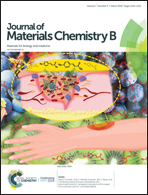Synergistic antitumor efficacy of hybrid micelles with mitochondrial targeting and stimuli-responsive drug release behavior†
Abstract
The term synergism means that the overall therapeutic benefits should be greater than the sum of the effects of individual agents and that the optimal therapeutic efficacy can be achieved at reduced doses. Micellar systems usually fail to deliver multiple drugs to target sites at synergistic doses and thus are not able to maximize the antitumor efficacy. In the current study, we demonstrate a strategy to coordinate the release of camptothecin (CPT) and α-tocopheryl succinate (TOS) from hybrid micelles for nucleus and mitochondrion interferences. TOS is decorated with cationic triphenylphosphonium (TPP) to promote the targeting capability of TOS-TPP to mitochondria. The combination of CPT and TOS-TPP shows strong synergistism with a combination index of 0.186. Hyaluronic acid (HA) is conjugated with CPT or TOS-TPP via disulfide linkages for tumor cell targeting and intracellular reduction-triggered release. Both conjugates either separately self-assemble into MC and MT micelles, or are blended at different ratios to form MC–T hybrid micelles. In response to elevated intracellular glutathione levels, the coordinated release of CPT and TOS-TPP from MC–T results in a combination index of 0.26 and the dose-reduction indexes of CPT and TOS are 7.7 and 3.4, respectively. Compared with MC and MT, MC–T micelles with 5 fold lower doses exhibit higher intracellular reactive oxygen species (ROS) levels, comparable tumor growth inhibition and animal survival, indicating no hematologic and intestinal toxicities. Moreover, the HA conjugates of MC–T are linked to polylactide via acid-labile linkages and electrospun into short fibers (MC–T@SF) as an injectable depot to release MC–T in response to the acidic tumor microenvironment. At a predetermined synergistic ratio, MC–T@SF with 5 fold lower doses achieves antitumor profiles comparable to those of individual micelle-loaded short fibers. Therefore, the hybrid micelles and micelle-releasing short fibers represent a feasible strategy to synergistically enhance the therapeutic efficacy and enable significant reduction in effective doses of chemotherapeutic agents.



 Please wait while we load your content...
Please wait while we load your content...